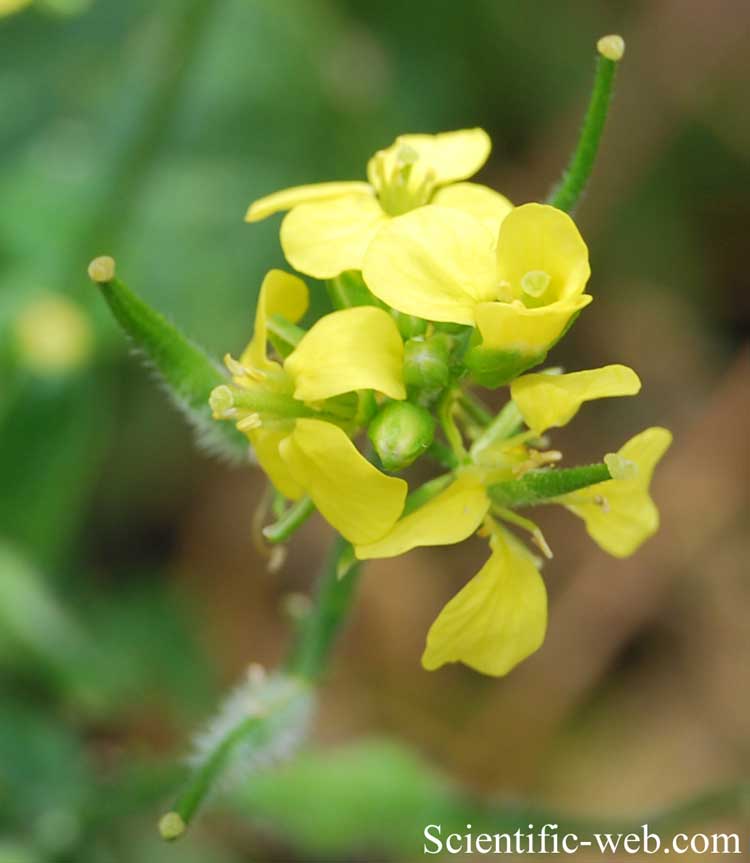
Sinapis alba, Photo: Michael Lahanas
Classification System: APG IV
Superregnum: Eukaryota
Regnum: Plantae
Cladus: Angiosperms
Cladus: Eudicots
Cladus: Core eudicots
Cladus: Rosids
Cladus: Eurosids II
Ordo: Brassicales
Familia: Brassicaceae
Tribus: Brassiceae
Genus: Sinapis
Species: Sinapis alba
Subspecies: S. a. subsp. alba – S. a. subsp. dissecta – S. a. subsp. mairei
Name
Sinapis alba L.
Synonyms
Bonnania officinalis C. Presl
References
Linnaeus, C. 1753. Species Plantarum. Tomus II: 668. Reference page.
Links
Koch, M.A. et al. 2019. Sinapis alba in BrassiBase Tools and biological resources to study characters and traits in the Brassicaceae. Published on the internet. Accessed: 2019 May 26.
International Plant Names Index. 2019. Sinapis alba. Published online. Accessed: May 26 2019.
The Plant List 2013. Sinapis alba in The Plant List Version 1.1. Published on the internet. Accessed: 2019 May 26.
Tropicos.org 2019. Sinapis alba. Missouri Botanical Garden. Published on the internet. Accessed: 2019 May 26.
USDA, ARS, Germplasm Resources Information Network. Sinapis alba in the Germplasm Resources Information Network (GRIN), U.S. Department of Agriculture Agricultural Research Service. Accessed: 09-Oct-10.
Vernacular names
български: Бял синап
Deutsch: Weißer Senf
ދިވެހިބަސް: ރީނދޫ ރެވި
Ελληνικά, Κυπριακά : Γρούα, Λαψάνα, Μαντολαψάνα
English: white mustard, yellow mustard
español: Mostaza blanca
eesti: Valge sinep
suomi: Keltasinappi
français: Moutarde blanche
galego: Mostaza branca
Bahasa, Indonesia: Sesawi putih
日本語: シロガラシ
lietuvių: Baltoji garstyčia
македонски: Бел синап
Nederlands: Witte mosterd, gele mosterd
polski: Gorczyca biała
Runa Simi: Yuraq mustasa
română: Muştar alb
русский: Горчица белая
slovenčina: Horčica biela
svenska: Vitsenap
Türkçe: Beyaz hardal
White mustard (Sinapis alba) is an annual plant of the family Brassicaceae. It is sometimes also referred to as Brassica alba or B. hirta. Grown for its seeds, used to make the condiment mustard, as fodder crop, or as a green manure, it is now widespread worldwide, although it probably originated in the Mediterranean region.
Description
White mustard is an annual, growing to 70 cm high with stalkless pinnate leaves, similar to Sinapis arvensis.[1]
Distribution
Most common in Europe, North Africa, the Middle East and Central Asia, it can be found worldwide. It has been found as far north as Greenland,[2] and naturalized throughout Great Britain and Ireland.[3]
Culinary uses
The yellow flowers of the plant produce glabrous or sparsely bristled siliquae. Each fruit (silique) contains roughly a half dozen seeds. The plants are harvested for their seeds just prior to the seed pods (siliquae) becoming ripe and bursting open (dehiscing).
White mustard seeds are hard spheroid seeds, usually around 1.0 to 1.5 mm (0.039 to 0.059 in) in diameter,[4] with a color ranging from beige or yellow to light brown. They can be used whole for pickling or toasted for use in dishes. When ground and mixed with other ingredients, a paste or more standard condiment can be produced. Sinapis alba is used to make the commonplace yellow table mustard, with additional yellow coloring provided by turmeric in some formulations.
The seeds contain sinalbin, which is a thioglycoside responsible for their pungent taste. White mustard has fewer volatile oils and the flavor is considered to be milder than that produced by black mustard seeds.[5][6]
In Greece, the plant's leaves are eaten during the winter, before it blooms. Greeks call it vrouves (βρούβα) or lapsana (λαψάνα). The blooming season of this plant (February–March) is celebrated with the Mustard Festival, a series of festivities in the wine country of California (Napa and Sonoma Counties).
Other uses
White mustard is commonly used as a cover and green manure crop in Europe (between UK and Ukraine). A large number of varieties exist, e.g. in Germany, Netherlands, mainly differing in lateness of flowering and resistance against white beet-cyst nematode (Heterodera schachtii). Farmers prefer late-flowering varieties, which do not produce seeds, as they may become weeds in the subsequent year. Early vigour is important to cover the soil quickly to suppress weeds and protect the soil against erosion. In rotations with sugar beets, suppression of the white beet-cyst nematode is an important trait. Resistant white mustard varieties reduce nematode populations by 70-90%.
References
Webb, D.A., Parnell, J. and Doogue, D. 1996. An Irish Flora. Dundalgan Press Ltd., Dundalk. ISBN 0-85221-131-7
Beesley, S. and Wilde, J. 1997. Urban Flora of Belfast. The Institute of Irish Studies and The Queen's University of Belfast. ISBN 0-85389-695-X.
Clapham, A.R., Tutin, T.G. and Warburg, E.F. 1968 Excursion Flora of the British Isles. Cambridge University Press. ISBN 0-521-04656-4
Balke, D. (2000). "Rapid aqueous extraction of mucilage from whole white mustard seed". Food Research International. 33 (5): 347–356. doi:10.1016/S0963-9969(00)00055-7.
Tan, S. H. (2011). "Extraction and residual antinutritional components in protein fractions of Sinapis alba and Brassica napus oil-free meals". 17th Australian Research Assembly on Brassicas (ARAB). Wagga Wagga, NSW: 107.
Garland, S. (1993). The Complete Book of Herbs & Spices: An Illustrated Guide to Growing and Using Culinary, Aromatic, Cosmetic and Medicinal Plants. Frances Lincoln Limited, Rydalmere, NSW, Australia. ISBN 978-0340584699.
Retrieved from "http://en.wikipedia.org/"
All text is available under the terms of the GNU Free Documentation License

